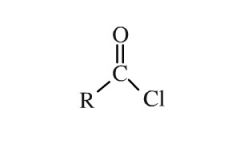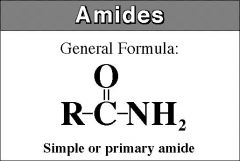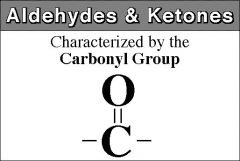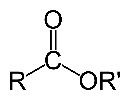![]()
![]()
![]()
Use LEFT and RIGHT arrow keys to navigate between flashcards;
Use UP and DOWN arrow keys to flip the card;
H to show hint;
A reads text to speech;
130 Cards in this Set
- Front
- Back

an acid derivative with a chlorine atom in place of the hydroxyl group
|
acid chloride
|
|
|
a compound that contains a hydroxyl group;
R -- OH |
alcohol
|
|

a carbonyl group with one alkyl group and one hydrogen
|
aldehyde
|
|
|
hydrocarbons containing only single bonds
|
alkanes
|
|
|
hydrocarbons containing C = C double bonds
|
alkenes
|
|
|
hydrocarbons containing C - C triple bonds
|
alkynes
|
|
|
a hydrocarbon group with only single bonds; an alkane with one hydrogen removed, to allow bonding to another group; symbolized by R
|
alkyl group
|
|
|
an acid derivative that contains an amine instead of the hydroxyl group of the acid.
|

amide
|
|
|
an alkylated analogue of ammonia;
R -- NH2 R2NH R3N |
amine
|
|
|
hydrocarbons containing a benzene ring, a six-membered ring with three double bonds
|
aromatic hydrocarbons (arenes)
|
|
|
a measure of the polarity of an individual bond in a molecule, defined as u = (4.8 * d * S), where u is the dipole moment in debyes, d is the bond length in angstroms, and S is the effective amount of charge separated, in units of electronic charge
|
bond dipole moment
|
|
|
the functional group, as in a keton or aldehyde
|

carbonyl group
|
|
|
the -COOH functional group
|
carboxyl group
|
|
|
a compound that contains the carboxyl group
R - COOH |
carboxylic acid
|
|
|
stereoisomers that differ in their cis-trans arrangement on a ring or a double bond.
|
cis-trans isomers (geometric isomers)
|
|
|
has similar groups on the same side
|
cis isomer
|
|
|
has similar groups on opposite sides
|
trans isomer
|
|
|
isomers whose atoms are connected differently; they differ in their bonding sequence
|
constitutional isomers (structural isomers)
|
|
|
the --CN: (triple bond) functional group, as in a nitrile
|
cyano group
|
|
|
attractive intermolecular forces resulting from the attraction of the positive and negative ends of the molecular dipole moments of polar molecule
|
dipole-dipole forces
|
|
|
bond containing four electrons etween two nuclei. one pair of electrons forms a sigma bond, and the other pair forms a pi bond
|
double bond
|
|

an acid derivative with an alkyl group replacing the acid proton
|
ester
|
|
|
a compound with an oxygen bonded between two alkyl groups; R -- O -- R'
|
ether
|
|
|
the reactive, nonalkane part of an organic molecule
|
functional group
|
|
|
a directional orbital formed from a combination of s and p orbitals on the same atom. two orbitals are formed by sp hybridization, three orbitals by sp2 hybridization, and four orbitals by sp3 hybridization.
|
hybrid atomic orbital
|
|
|
gives a bond angle of 180 degrees and linear geometry
|
sp hybrid orbitals
|
|
|
gives a bond angle of 120 degrees and trigonal geometry
|
sp2 hybrid orbitals
|
|
|
gives bond angles of 109.5 degrees and tetrahedral geometry
|
sp3 hybrid orbitals
|
|
|
compounds composed exclusively of carbon and hydrogen
|
hydrocarbons
|
|
|
hydrocarbons containing only single bonds
|
alkanes
|
|
|
hydrocarbons containing C = C double bonds
|
alkenes
|
|
|
hydrocarbons containing C - C triple bonds
|
alkynes
|
|
|
alkanes, alkenes, and alkynes in the form of a ring
|
cycloalkanes, cycloalkenes, cycloalkynes
|
|
|
hydrocarbons containing a benzene ring, a six-membered ring with three double bonds
|
aromatic hydrocarbons
|
|
|
a particularly strong attraction between a nonbonding pair of electrons and an electrophilic O-H or N-H hydrogen. Have bond energies of about 5 kcal/mol, compared with about 100 kcal/mol for typical C-H bonds.
|
hydrogen bond
|
|
|
the -OH functional group, as in an alcohol
|
hydroxyl group
|
|
|
different compounds with the same molecular formula
|
isomers
|
|

a carbonyl group with two alkyl groups attached
|
ketone
|
|
|
wave functions can add to each other to produce the wave functions of new orbitals. The number of new orbitals generated equals the original number of orbitals
|
linear combination of atomic orbitals (LCAO)
|
|
|
intermolecular forces resulting from the attraction of correlated temporary dipole moments induced in adjacent molecules
|
London dispersion forces
|
|
|
the vector sum of the bond dipole moments (and any nonbonding pairs of electrons) in a molecule; a measure of the polarity of a molecule
|
molecular dipole moment
|
|
|
an orbital formed by the overlap of atomic orbitals on different atoms. Can be either bonding or antibonding, but only the bonding are filled in most stable molecules.
|
molecular orbital (MO)
|
|
|
places a large amount of electron density in the bonding region between the nuclei. The energy of an electron in ---- is lower than it is in an atomic orbital
|
bonding molecular orbital
|
|
|
places most of the electron density outside the bonding region. The energy of an electron in an --- is higher than it is in an atomic orbital
|
antibonding molecular orbital
|
|
|
a compound containing a cyano group.
-- CN: (triple bond) |
nitrile
|
|
|
in an orbital, a region of space with zero electron density
|
node
|
|
|
bond formed by sideways overlap of two p orbitals. Has its electron density in two lobes, one above and one below the line joining the nuclei.
|
pi bond
|
|
|
a bond with most of its electron density centered along the line joining the nuclei; a cylindrically symmetrical bond. Normally single bonds.
|
sigma bond
|
|
|
study of the structure and chemistry of stereoisomers
|
stereochemistry
|
|
|
isomers that differ only in how their atoms are oriented in space
|
stereoisomers
|
|
|
isomers whose atoms are connected differently; they differ in their bonding sequence
|
structural isomers (IUPAC term: constitutional isomer)
|
|
|
a bond containing six electrons between two nuclei. One pair of electrons forms a sigma bond and the other two pairs form two pi bonds at right angles to each other
|
triple bond
|
|
|
bonds and lone pairs around a central atom tend to be separated by the largest possible angles: about 180 degrees for two, 120 degrees for three, and 109.5 degrees for four.
|
valence-shell electron-pair repulsion theory (VSEPR theory)
|
|
|
the attractive forces between neutral molecules, including dipole-dipole forces and London forces
|
van der Waals forces
|
|
|
the forces between polar molecules resulting from attraction of their permanent dipole moments
|
dipole-dipole forces
|
|
|
intermolecular forces resulting from the attraction of correlated temporary dipole moments induced in adjacent molecules
|
London forces
|
|
|
the mathematical description of an orbital. the square of the --- is proportional to the electron density
|
wave function
|
|
|
two general kinds of waves
|
traveling waves
standing waves |
|
|
sound waves that carry a thunderclap
|
traveling waves
|
|
|
vibrate in a fixed location
|
standing waves
|
|
|
an electron in an atomic orbital is like a stationary, bound vibration
|
standing wave
|
|
|
when one is displaced upward, the other wave is displaced downward
|
out of phase
|
|
|
when orbitals on DIFFERENT atoms interact, they produce --- that lead to bonding (or antibonding)
|
molecular orbitals
|
|
|
when orbitals on the SAME atom interact, they give --- that define the geometry of the bonds
|
hybrid atomic orbitals
|
|
|
the stability of a covalent bond results from a large amount of --- in the ---, the space between the two nuclei
|
electron density
bonding region |
|
|
electrons close to both nuclei results in --- of the overall energy
|
lowering
|
|
|
the internuclear distance where attraction and repulsion are balanced, which also gives the minimum energy (the strongest bond)
|
bond length
|
|
|
1s wave functions reinforce each other
|
constructive
|
|
|
wave functions cancel out where they overlap
|
destructive
|
|
|
when wave functions reinforce each other and increase the electron density the result is ---.
|
bonding molecular orbital (bonding MO)
|
|
|
when wave functions overlap out of phase the result is ---.
|
antibonding molecular orbital
|
|
|
when the 1s orbitals are IN phase, the resulting molecular orbital is a ---, with --- energy than that of a 1s atomic orbital.
|
sigma bonding MO
lower |
|
|
When two 1s orbitals overlap OUT OF PHASE, they form an --- with --- energy than that of a 1s atomic orbital.
|
antibonding orbital
higher |
|
|
in stable molecules, the antibonding orbitals are usually ----
|
vacant
|
|
|
When two p orbitals overlap along the ling between the nuclei, a(n) --- orbital and a(n) ---- orbital result.
|
bonding
antibonding |
|
|
most of the electron density is centered along the ---.
|
line between the nuclei
|
|
|
overlap of an s orbital with a p orbital gives a --- and an ----.
|
bonding MO
antibonding MO |
|
|
p orbitals are oriented at -- degrees
|
90
|
|
|
-- degrees is the largest possible separation for four pairs of electrons
|
109.5
|
|
|
-- degrees is the largest separation for three pairs of electrons
|
120
|
|
|
-- degrees is the largest separation for two pairs of electrons
|
180
|
|
|
sp hybridization results in --- bonding and a bond angle of -- degrees
|
linear
180 |
|
|
sp2 hybrid orbitals composed of one -- and two -- orbitals; results in -- bonding and bond angles of -- degrees
|
s
p trigonal 120 |
|
|
sp3 are when --- bonds are oriented as far apart as possible, they form a --- shape and --- degree bond angles. It is a combination of the -- orbital with --- -- orbitals
|
4
tetrahedral 109.5 s 3 p |
|
|
pz orbital should look like it points -- and -- of the page
|
in and out
|
|
|
dashed lines indicate bonds that
|
go backward
|
|
|
wedge shaped bonds indicate bond that
|
come forward
|
|
|
straight lines are bonds that
|
are in the plane of the page
|
|
|
2 hybrid orbitals
s + p = sp hybridization ??? geometry ???? bond angle |
linear
180 degrees |
|
|
3 hybrid orbitals
s + p + p = sp2 hybridization ??? geometry ??? bond angle |
trigonal
120 degrees |
|
|
4 hybrid orbitals
s + p + p + p = sp3 hybridization ??? geometry ??? bond angle |
tetrahedral
109.5 degrees |
|
|
differs only in rotations about a single bond
|
conformations
|
|
|
rotation about single bonds is allowed, but --- are rigid and cannot be twisted
|
double bonds
|
|
|
bond dipole moment formula
|
u = S * d
u = 4.8 * S(electron charge) * d |
|
|
C-N dipole moment
--> |
.22 D
|
|
|
C-O dipole moment
--> |
.86 D
|
|
|
C--F dipole moment
--> |
1.51 D
|
|
|
C--Cl dipole moment
--> |
1.56 D
|
|
|
C--Br dipole moment
--> |
1.48 D
|
|
|
C--I dipole moment
--> |
1.29 D
|
|
|
H--C dipole moment
--> |
.3 D
|
|
|
H--N dipole moment
--> |
1.31 D
|
|
|
H--O dipole moment
--> |
1.53 D
|
|
|
C=O dipole moment
--> |
2.4 D
|
|
|
C-triplebond-N dipole moment
--> |
3.6 D
|
|
|
3 major kinds of attractive forces cause molecules to associate into solids and liquids
|
-dipole-dipole forces of polar molecules
-London forces that affect all molecules -hydrogen bonds that link molecules having -OH or -NH groups |
|
|
polar substance dissolve in ----
|
polar solvents
|
|
|
nonpolar substance dissolve in ---
|
nonpolar solvents
|
|
|
1 carbon
|
methane
|
|
|
2 carbons
|
ethane
|
|
|
3 carbons
|
propane
|
|
|
4 carbons
|
butane
|
|
|
5 carbons
|
pentane
|
|
|
6 carbons
|
hexane
|
|
|
7 carbons
|
heptane
|
|
|
8 carbons
|
octane
|
|
|
9 carbons
|
nonane
|
|
|
10 carbons
|
decane
|
|
|
major components of heating gases, undergo few reactions
|
alkanes
|
|
|
triple bond is --- (geometric)
|
linear
|
|
|
strongly polar
miscible with water R - OH |
alcohol
|
|
|
polar
no O - H R - O - R' |
ether
|
|
|
strongly polar
somewhat soluble in water miscible with water RCOR' |
ketone
|
|
|
strongly polar
somewhat soluble in water miscible with water RCHO |
aldehyde
|
|
|
R - COOH
pKa ~ 5 resonance stabilized strongly polar soluble in water miscible with water |
carboxylic acid
|
|
|
R - CONH2
most stable acid derivative not as basic as amine very weak base |
amide
|
|
|
R - COCl
|
acid chloride
|
|
|
R - COOR'
|
ester
|
|
|
basic
Kb~ 10 ^-3 R - :NH2 R - :NH - R' R - :N - R" | R' |
amine
|
|
|
R - CN: (triple bond)
contains cyano group |
nitrile
|

